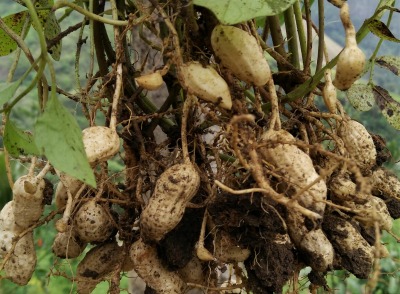The planting of seeds is an essential operation in growing peanut. It’s what the production guides, both online and printed, require.
Peanut technicians and graduates in agriculture say the same.
Seasoned farmers do it without thinking of any other way. And peanut cannot be ratooned.
But I did grow peanut without planting!
No, not the first but rather the second peanut crop. It was in fact unintentional that I raised the second.

During the first cropping I planted about 40 kg of seeds.
Thirty (30) kg belong to a variety which the vendor at the public market from whom I purchased the seeds called Native White.
The seeds were plump and clearly bigger than those of the variety called Imelda.
She also said that the variety is widely grown in San Jose, General Santos City.
I found later that Native White has smaller pods (rarely with 4 seeds per pod) than those of Imelda.
The former has scant demand for freshly harvested pods but the dry seeds have unlimited market at a bigger selling price.
The separate 10-kg seeds were of the Red variety.
This variety is mainly marketted as dry seeds but there are also buyers of fresh pods at limited volume.
My buyer explained that she was only capable of absorbing 10-15 sacks of fresh pods per week.
These seeds were sown in the first week of June 2018.
Harvesting was late, that is, more than 100 days after planting because it was only then that farm worker-harvesters became available.
This anomaly led to the second crop without intentional planting.
How I grew peanut as a second crop
The peanut plants had become overmature when harvesting was commenced.
Many seeds within pods started germinating there being sufficient soil moisture due to frequent rainfall.
When uprooted, many pods were left underground because the pegs which connected the pods to the stems had become brittle and were easily severed.
These leftover seeds in pods subsequently grew.
Later, there was thick growth of new peanuts. Instead of eradicating the plants as weed, I decided to manage them as second crop.
Lessons and Discovery in Growing Peanut
That’s it, we discovered by accident that peanut can be grown without the act of planting seeds.
To qualify, however, this applies only to the succeeding second crop even though indirectly these new plants originated from the seeds that were planted for the first crop.
Further, this also revealed that peanut can likely be grown using intact pods as planting materials where sufficient soil moisture can be maintained or there is frequent rainfall.
However, I admit that the comparative advantage of propagating peanut from intact pods needs to be tested and confirmed.
If proved right, growing peanut from pods will be beneficial in terms of reduced cost as shelling can be dispensed with.
Peanut farmers can also save time because planting can possibly be advanced.
